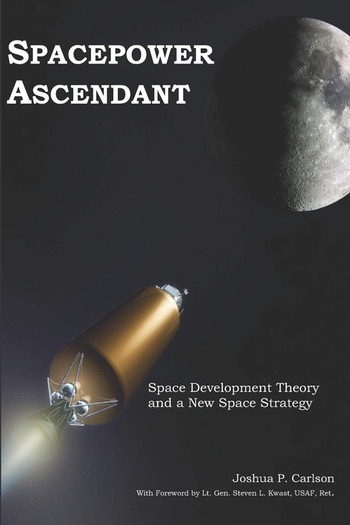|
|
Review: Spacepower Ascendant
by Jeff Foust
Monday, November 23, 2020

Spacepower Ascendant: Space Development Theory and a New Space Strategy
By Joshua P. Carlson
independently published, 2020
paperback, 257 pp., illus.
ISBN 979-8655659230
US$19.99
This week’s launch of China’s Chang’e-5 lunar sample return mission will doubtless reinvigorate claims of a space race between the US and China, including those who believe the US is falling behind China in such a competition. The Chinese effort will likely be depicted as part of a grand strategy by China to harness the resources of the Moon (water, rare earth elements, helium-3, etc.), if not seize the Moon itself, to become the dominant power in space and therefore on Earth. If America does not respond, they argue, it risks ultimately being subservient to China.
That is a theme found in Spacepower Ascendant by Joshua P. Carlson, a recent graduate of the Air Command and Staff College who studied space strategy there. In the book, he lays out a theory of spacepower—analogous to the seapower theories of Mahan and others—intended to guide the future of the US in space in particular, particularly against that perceived competition with China.
His theory of space development outlines four alliterative phases of space activity: exploration, expansion, exploitation, and exclusion. Exploration provides the knowledge to support an expansion of activities in space, which then allows those resources to be exploited commercially. Exclusion, as the name suggests, is preventing others from exploring, expanding, or exploiting the same regions of space.
That is a straightforward framework. Applied to Earth orbit, it’s clear we’re at the exploitation phase: countries and companies use the “resources” of Earth orbit—its location—to provide communications, imaging, and other services. Beyond Earth orbit, though, and space development is still firmly in the exploration phase.
The problem Carlson sees is that American space strategy “has an undercurrent of parochial satellite-centric thinking that prioritizes security, stability, and maintaining current advantages.” China, he argues, is more forward thinking, embracing that space development strategy in terms of moving up the chain to expansion, exploitation, and exclusion. He offers a scenario where China develops lunar resources and space-based solar power, becoming the dominant country on space and Earth by mid-century with the ability to exclude the US and others from those riches. Even SpaceX and its plans for Martian settlements is not immune: he predicts that SpaceX will be forced to accept protection of that settlement from “China’s Nuclear Fleet.”
| The problem Carlson sees is that American space strategy “has an undercurrent of parochial satellite-centric thinking that prioritizes security, stability, and maintaining current advantages.” China, he argues, is more forward thinking. |
However, it’s not at all clear that China’s approach to space is anything line that described in the book. Carlson describes a Chinese strategy that calls for starting development of space-based solar power systems in the 2020s, a lunar base in the 2030s, and a “nuclear-powered space fleet” by 2040. There is scant evidence, though, that is an official plan backed by the Chinese government: he refers primarily to secondary sources and views of outside analysts as the basis for this. It is, perhaps, what those analysts think China should do, or what they would do if they had those resources available, but not necessarily what China is actually carrying out, at least on anything like the timetable described in the book. It is reminiscent of predictions more than a decade ago that China would land humans on the Moon by 2020 when, in fact, it has not launched a crewed mission to Earth orbit in four years as it slowly develops a space station.
China’s space strategy, as least as far as can be publicly seen, is much more like that “parochial satellite-centric thinking” the US is criticized for in the book: China is growing various space capabilities in Earth orbit, many of them similar to those the US and other have, like a navigation satellite constellation and an increasing number of intelligence satellites. It has also, of course, demonstrated counterspace capabilities like anti-satellite weapons, much to the consternation of the US military, but the asymmetric advantage they once offered many be diminishing as China, like the US, grows increasingly reliant on space capabilities.
This doesn’t mean the space development theory outlined in the book is flawed: it is, at least in general, a logical progression from simply exploring space to utilizing it, and can be the framework for shaping future policies to advance from exploration to exploitation. Its application here, though, may miss the mark simply because Chinese space ambitions may not be all that different from those of the US.
Jeff Foust (jeff@thespacereview.com) is the editor and publisher of The Space Review, and a senior staff writer with SpaceNews. He also operates the Spacetoday.net web site. Views and opinions expressed in this article are those of the author alone.
Note: we are temporarily moderating all comments submitted to deal with a surge in spam.
|
|
